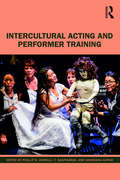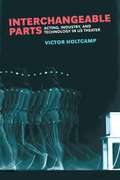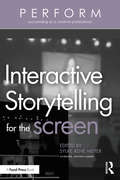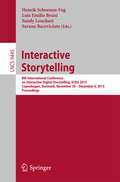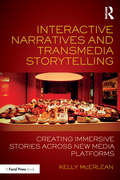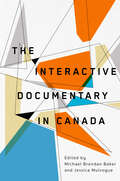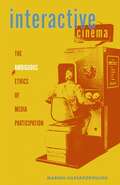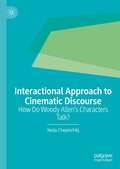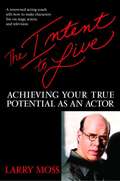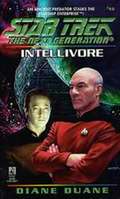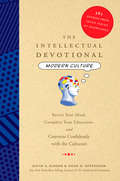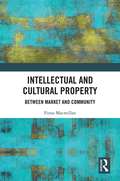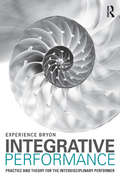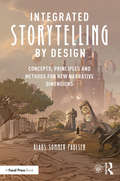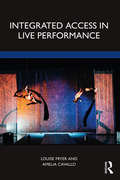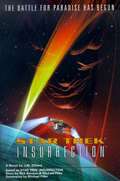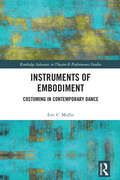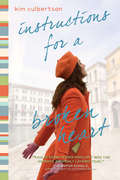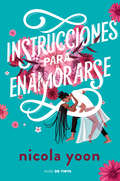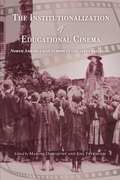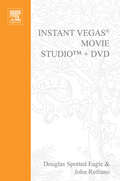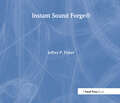- Table View
- List View
Intercultural Acting and Performer Training
by Zarrilli Phillip T Sasitharan Anuradha KapurIntercultural Acting and Performer Training is the first collection of essays from a diverse, international group of authors and practitioners focusing on intercultural acting and voice practices worldwide. This unique book invites performers and teachers of acting and performance to explore, describe, and interrogate the complexities of intercultural acting and actor/performer training taking place in our twenty-first century, globalized world. As global contexts become multi-, inter- and intra-cultural, assumptions about what acting "is" and what actor/performer training should be continue to be shaped by conventional modes, models, techniques and structures. This book examines how our understanding of interculturalism changes when we shift our focus from the obvious and highly visible aspects of production to the micro-level of training grounds, studios, and rehearsal rooms, where new forms of hybrid performance are emerging. Ideal for students, scholars and practitioners, Intercultural Acting and Performer Training offers a series of accessible and highly readable essays which reflect on acting and training processes through the lens offered by "new" forms of intercultural thought and practice.
Interchangeable Parts: Acting, Industry, and Technology in US Theater (Theater: Theory/Text/Performance)
by Victor HoltcampWhile Hollywood has long been called “The Dream Factory,” and theatrical entertainment more broadly has been called “The Industry,” the significance of these names has rarely been explored. There are in fact striking overlaps between industrial rhetoric and practice and the development of theatrical and cinematic techniques for rehearsal and performance. Interchangeable Parts examines the history of acting pedagogy and performance practice in the United States, and their debts to industrial organization and philosophy. Ranging from the late nineteenth century through the end of the twentieth, the book recontextualizes the history of theatrical technique in light of the embrace of industrialization in US culture and society. Victor Holtcamp explores the invocations of scientific and industrial rhetoric and philosophy in the founding of the first schools of acting, and echoes of that rhetoric in playwriting, production, and the cinema, as Hollywood in particular embraced this industrially infected model of acting. In their divergent approaches to performance, the major US acting teachers (Lee Strasberg, Stella Adler, and Sanford Meisner) demonstrated strong rhetorical affinities for the language of industry, illustrating the pervasive presence of these industrial roots. The book narrates the story of how actors learned to learn to act, and what that process, for both stage and screen, owed to the interchangeable parts and mass production revolutions.
Interactive Storytelling for the Screen (PERFORM)
by Sylke Rene MeyerAn invaluable collection of essays and interviews exploring the business of interactive storytelling, this highly accessible guide offers invaluable insight into an ever-evolving field that is utilizing new spatial and interactive narrative forms to tell stories. This includes new media filmmaking and content creation, a huge variety of analog story world design, eXtended realities, game design, and virtual reality (VR) design. The book contains essays written by and interviews with working game designers, producers, 360-degree filmmakers, immersive theatre creators, and media professors, exploring the business side of interactive storytelling – where art meets business. Contributors to this book share their perspectives on how to break into the field; how to develop, nurture, and navigate business relationships; expectations in terms of business etiquette; strategies for contending with the emotional highs and lows of interactive storytelling; how to do creative work under pressure; the realities of working with partners in the field of new media narrative design; prepping for prototyping; writing analog and digital. This is an ideal resource for students of filmmaking, screenwriting, media studies, RTVF, game design, VR and AR design, theater, and journalism who are interested in navigating a career pathway in the exciting field of interactive storytelling.
Interactive Storytelling
by Henrik Schoenau-Fog Luis Emilio Bruni Sandy Louchart Sarune BaceviciuteThis book constitutes the refereed proceedings of the 8th International Conference on Interactive Digital Storytelling, ICIDS 2015, held in Copenhagen, Denmark, in November/December 2015. The 18 revised full papers and 13 short papers presented together with 9 posters, 9 workshop descriptions, and 3 demonstration papers were carefully reviewed and selected from 80 submissions. The papers are organized in topical sections on theoretical and design foundations, technical advances, analyses and evaluation systems, and current and future usage scenarios and applications.
Interactive Narratives and Transmedia Storytelling: Creating Immersive Stories Across New Media Platforms
by Kelly McErleanInteractive Narratives and Transmedia Storytelling provides media students and industry professionals with strategies for creating innovative new media projects across a variety of platforms. Synthesizing ideas from a range of theorists and practitioners across visual, audio, and interactive media, Kelly McErlean offers a practical reference guide and toolkit to best practices, techniques, key historical and theoretical concepts, and terminology that media storytellers and creatives need to create compelling interactive and transmedia narratives. McErlean takes a broad lens, exploring traditional narrative, virtual reality and augmented reality, audience interpretation, sound design, montage, the business of transmedia storytelling, and much more. Written for both experienced media practitioners and those looking for a reference to help bolster their creative toolkit or learn how to better craft multiplatform stories, Interactive Narratives and Transmedia Storytelling serves as a guide to navigating this evolving world.
The Interactive Documentary in Canada
by Michael Brendan Baker and Jessica MulvogueInteractive documentary emerged rapidly from a constellation of changing technologies and practices to much excitement, yet its history is short and its future uncertain. In the mid-2010s Canada was a world leader in the creation of i-docs. Less than a decade later technological obsolescence has rendered many of these celebrated projects inaccessible, while rapid digital innovation continues to change the i-doc form and its modes of experience.The Interactive Documentary in Canada captures this transitional moment in documentary filmmaking and media production. Bringing together a range of historical, theoretical, and critical approaches, this collection examines the past – and the imagined future – of a nonfiction storytelling phenomenon that has Canadian institutions, figures, and works at its centre. Embracing a polyphonic conception of interactive documentary, the volume includes explorations of web-based, app-based, installation, and virtual reality works that push the boundaries of what is understood as documentary cinema. Leading documentary scholars and makers consider the historical and technological contexts of i-doc production, innovation, and exhibition; the political and pedagogical potential of the genre; the ethics of the i‐doc experience; and the format’s future lifespan in the contemporary media landscape.The Interactive Documentary in Canada establishes a place for the i-doc in the history of Canadian film, highlighting the genre’s significant impact on the National Film Board of Canada and on contemporary global documentary media.
Interactive Cinema: The Ambiguous Ethics of Media Participation (Electronic Mediations #63)
by Marina HassapopoulouConnecting interactive cinema to media ethics and global citizenship Interactive Cinema explores various cinematic practices that work to transform what is often seen as a primarily receptive activity into a participatory, multimedia experience. Surveying a multitude of unorthodox approaches throughout the history of motion pictures, Marina Hassapopoulou offers insight into a range of largely ephemeral and site-specific projects that consciously assimilate viewers into their production. Analyzing examples of early cinema, Hollywood B movies, museum and gallery installations, virtual-reality experiments, and experimental web-based works, Hassapopoulou travels across numerous platforms, highlighting a diverse array of strategies that attempt to unsettle the allegedly passive spectatorship of traditional cinema. Through an exploration of these radically inventive approaches to the medium, many of which emerged out of sociopolitical crises and periods of historical transition, she works to expand notions of interactivity by considering it in both technological and phenomenological terms. Deliberately revising and expanding Eurocentric scholarship to propose a much broader, transnational scope, the book emphasizes the ethical dimensions of interactive media and their links to larger considerations around community building, citizenship, and democracy. By combining cutting-edge theory with updated conventional film studies methodologies, Interactive Cinema presses at the conceptual limits of cinema and offers an essential road map to the rapidly evolving landscape of contemporary media.
Interactional Approach to Cinematic Discourse: How Do Woody Allen’s Characters Talk?
by Neda ChepinchikjThis book analyses and describes a segment of Woody Allen’s cinematic discourse, focusing specifically on the performed (or diegetic) interactions between actors in various roles in some of his films. It is a case study of Woody Allen's cinematic discourse, encompassing the on-screen, performed interaction in the films at the level of the story-world. The analysis focuses on speech (film dialogues), in both its verbal and prosodic forms, as well as non-verbal types of interaction including gaze and gesture, taking a social interactional approach and using multimodal conversation analysis as a theoretical framework and analytical tool. The 'texts' under study are segments from five films by Woody Allen, and the analysed interactions take place between male and female interactants, which allows further examination of on-screen interactions via a gender lens. The book aims to bridge the gap between the disciplines of applied linguistics and cinema studies and offer linguistic insights into performed interactions from a multimodal point of view. It will be equally relevant to linguists who are interested in how verbal and non-verbal language is used in cinematic discourse, as well as to film workers, especially actors, directors and screenwriters.
The Intent to Live: Achieving Your True Potential as an Actor
by Larry Moss"I call this book The Intent to Live because great actors don't seem to be acting, they seem to be actually living." -Larry Moss, from the Introduction. When Oscar-winning actors Helen Hunt and Hilary Swank accepted their Academy Awards, each credited Larry Moss's guidance as key to their career-making performances.
Intellivore (Star Trek #45)
by Diane DuaneThe Great Rift lies between the Sagitarius and Orion arms of the galaxy. Stars are scarce there, beyond the authority of the Federation, and legends abound of lost civilizations and of ancient monsters that prey on those who dare to venture into the vast darkness between the stars. When several ships and colonies mysteriously disappear into the Rift, the U.S.S. Enterprise leads an expedition to investigate various disturbing reports. Accompanied by two other Federation starships, Picard and his fellow captains discover a bizarre menace of unimaginable power. And the only way to trap this destructive entity is to use the Enterprise as bait.
The Intellectual Devotional: Revive Your Mind, Complete Your Education, and Converse Confidently with the Cul turati (The Intellectual Devotional Series)
by David S. Kidder Noah D. OppenheimIn the tradition of the instant bestsellers The Intellectual Devotional and The Intellectual Devotional: American History comes the third installment in this indispensable series. <P><P> In The Intellectual Devotional: Modern Culture, authors David S. Kidder and Noah D. Oppenheim explore the fascinating world of contemporary culture to offer 365 daily readings that provide the essential references needed to navigate the world today. <P><P>Quench your intellectual thirst with an overview of the literature, music, film, personalities, trends, sports, and pop references that have defined the way we live. From the Slinky to Star Wars; Beatlemania to Babe Ruth; flappers to fascism—refreshing your memory and dazzling your friends has never been easier, or more fun. <P>Whether you're a trivia genius, pop-culture buff, or avid reader, you'll be riveted by this comprehensive journey through contemporary culture.
Intellectual and Cultural Property: Between Market and Community
by Fiona MacmillanThis book focuses on the fraught relationship between cultural heritage and intellectual property, in their common concern with the creative arts. The competing discourses in international legal instruments around copyright and intangible cultural heritage are the most obvious manifestation of this troubled encounter. However, this characterization of the relationship between intellectual and cultural property is in itself problematic, not least because it reflects a fossilized concept of heritage, divided between things that are fixed and moveable, tangible and intangible. Instead the book maintains that heritage should be conceived as part of a dynamic and mutually constitutive process of community formation. It argues, therefore, for a critically important distinction between the fundamentally different concepts of not only intellectual and cultural heritage/property, but also of the market and the community. For while copyright as a private property right locates all relationships in the context of the market, the context of cultural heritage relationships is the community, of which the market forms a part but does not – and, indeed, should not – control the whole. The concept of cultural property/heritage, then, is a way of resisting the reduction of everything to its value in the market, a way of resisting the commodification, and creeping propertization, of everything. And, as such, the book proposes an alternative basis for expressing and controlling value according to the norms and identity of a community, and not according to the market value of private property rights. An important and original intervention, this book will appeal to academics and practitioners in both intellectual property and the arts, as well as legal and cultural theorists with interests in this area.
Integrative Performance: Practice and Theory for the Interdisciplinary Performer
by Experience BryonIntegrative Performance serves a crucial need of 21st-century performers by providing a transdisciplinary approach to training. Its radical new take on performance practice is designed for a climate that increasingly requires fully rounded artists. The book critiques and interrogates key current practices and offers a proven alternative to the idea that rigorous and effective training must separate the disciplines into discrete categories of acting, singing, and dance. Experience Bryon’s Integrative Performance Practice is a way of working that will profoundly shift how performers engage with their training, conditioning and performance disciplines. It synthesizes the various elements of performance work in order to empower the performer as they practice across disciplines within any genre, style or aesthetic. Theory and practice are balanced throughout, using: Regular box-outs, introducing the work's theoretical underpinnings through quotes, case studies and critical interjections. A full program of exercises ranging from training of specific muscle groups, through working with text, to more subtle structures for integrative awareness and presence. This book is the result of over twenty years of practice and research working with interdisciplinary artists across the world to produce a training that fully prepares performers for the demands of contemporary performance and all its somatic, emotive and vocal possibilities.
Integrated Storytelling by Design: Concepts, Principles and Methods for New Narrative Dimensions
by Klaus Sommer PaulsenThis pioneering work equips you with the skills needed to create and design powerful stories and concepts for interactive, digital, multi-platform storytelling and experience design that will take audience engagement to the next level. Klaus Sommer Paulsen presents a bold new vision of what storytelling can become if it is reinvented as an audience-centric design method. His practices unlock new ways of combining story with experience for a variety of existing, new and upcoming platforms. Merging theory and practice, storytelling and design principles, this innovative toolkit instructs the next generation of creators on how to successfully balance narratives, design and digital innovation to develop strategies and concepts that both apply and transcend current technology. Packed with theory and exercises intended to unlock new narrative dimensions, Integrated Storytelling by Design is a must-read for creative professionals looking to shape the future of themed, branded and immersive experiences.
Integrated Access in Live Performance
by Louise Fryer Amelia CavalloTwelve per cent of UK theatregoers have a disability. This compares with 18% of the UK’s adult population. Directors can help build audiences as diverse as the population at large by making their art accessible to all. Live performances are increasingly being made accessible to people with sensory impairments not only to satisfy equality laws and the requirements of funding bodies, but also in the interest of diversity and as a catalyst for creativity. But how do you ensure you don’t throw out the access baby with the artistic bathwater? This book draws on the results of the Integrated Access Inquiry: Is It Working? A qualitative study with 20 theatremakers from around the UK, it was commissioned by Extant Theatre – the UK’s leading company of blind and visually impaired people, and combines feedback from disabled audiences with advice from the creative teams who have experimented with integrating access. It discusses the challenges and opportunities of working with disabled actors and building in audience access even before rehearsals begin. It offers strategies, case studies and a step-by-step guide to help creative people integrate access into their live performance for the benefit of all.
Insurrection: Star Trek Ix Movie Novelization (Star Trek )
by J M DillardAgainst a background of an idyllic and peaceful world of eternal youth, a damaged Data goes wild, shutting down the isolation devices which conceal a Federation observation post from the native Baku. Picard is informed by the Admiral Dougherty that Data has taken the observation team and a party of Son'a delegates hostage. Now Picard enters a race against time to shut Data down and rescue the hostages. But the hostages, who are growing younger, have no desire to leave and Picard finds himself facing a terrible conflict between his principles and his orders from Starfleet.
Instruments of Embodiment: Costuming in Contemporary Dance (Routledge Advances in Theatre & Performance Studies)
by Eric MullisInstruments of Embodiment draws on fashion theory and the philosophy of embodiment to investigate costuming in contemporary dance. It weaves together philosophical theory and artistic practice by closely analyzing acclaimed works by contemporary choreographers, considering interviews with costume designers, and engaging in practice-as-research. Topics discussed include the historical evolution of contemporary dance costuming, Merce Cunningham’s innovative collaborations with Robert Rauschenberg, and costumes used in Ohad Naharin’s Virus (2001) and in a ground-breaking Butoh solo by Tatsumi Hijikata. The relationship between dance costuming and high fashion, wearable computing, and the role costume plays in dance reconstruction are also discussed and, along the way, an anarchist materialism is articulated which takes an egalitarian view of artistic collaboration and holds that experimental costume designs facilitate new forms of embodied experience and ways of seeing the body. This study will be of great interest to students and scholars working in performance philosophy, philosophy of embodiment, dance and performance studies, and fashion theory.
Instructions for a Broken Heart
by Kim CulbertsonThree days before her drama club's trip to Italy, Jessa Gardner discovers her boyfriend in the costume barn with another girl. Jessa is left with a care package from her best friend titled "Top Twenty Reasons He's a Slimy Jerk Bastard," instructing her to do one un-Jessa-like thing each day of the trip. At turns hilarious and heartwrenching, Instructions for a Broken Heart paints a magical Italy in which Jessa learns she must figure out life-and romance-for herself.
Instrucciones para enamorarse
by Nicola YoonUn libro para enamorarse, incluso para los que ya no creen en el amor. Evie Thomas ya no cree en el amor. Cuando sus padres se separaron, todos sus ideales sobre el amor se esfumaron. Sin embargo, las casualidades de la vida la llevan a aprender a bailar en la Escuela de Baile La Brea, donde conoce a un enigmático chico. X es completamente opuesto a Evie: atrevido, pasional, sin miedo. El tipo de persona que dice sí a todo, incluso a apuntarse a una competición de bailes de salón con una chica que acaba de conocer. Enamorarse de X no es lo que Evie tenía en mente. Si su experiencia le ha enseñado algo, es que nadie escapa del amor sin resultar herido. Pero mientras Evie y X bailan y se conocen más, la magia del amor arrasa con todo. Instrucciones para enamorarse es la nueva novela de Nicola Yoon, la autora bestseller de las novelas Todo todo y El sol también es una estrella. Un libroperfecto para amantes del romance, y para fans de Todo este tiempo o Bajo la misma estrella.
The Institutionalization of Educational Cinema: North America and Europe in the 1910s and 1920s
by Marina Dahlquist and Joel FrykholmEssays by scholars on how film has been used by schools, libraries, governments, and organizations for educational purposes.The potential of films to educate has been crucial for the development of cinema intended to influence culture, and is as important as conceptions of film as a form of art, science, industry, or entertainment. Using the concept of institutionalization as a heuristic for generating new approaches to the history of educational cinema, contributors to this volume study the co-evolving discourses, cultural practices, technical standards, and institutional frameworks that transformed educational cinema from a convincing idea into an enduring genre. The Institutionalization of Educational Cinema examines the methods of production, distribution, and exhibition established for the use of educational films within institutions—such as schools, libraries, and industrial settings—in various national and international contexts and takes a close look at the networks of organizations, individuals, and government agencies that were created as a result of these films’ circulation. Through case studies of educational cinemas in different North American and European countries that explore various modes of institutionalization of educational film, this book highlights the wide range of vested interests that framed the birth of educational and nontheatrical cinema.
The Institutionalization of Educational Cinema: North America and Europe in the 1910s and 1920s
by Marina Dahlquist and Joel FrykholmEssays by scholars on how film has been used by schools, libraries, governments, and organizations for educational purposes.The potential of films to educate has been crucial for the development of cinema intended to influence culture, and is as important as conceptions of film as a form of art, science, industry, or entertainment. Using the concept of institutionalization as a heuristic for generating new approaches to the history of educational cinema, contributors to this volume study the co-evolving discourses, cultural practices, technical standards, and institutional frameworks that transformed educational cinema from a convincing idea into an enduring genre. The Institutionalization of Educational Cinema examines the methods of production, distribution, and exhibition established for the use of educational films within institutions—such as schools, libraries, and industrial settings—in various national and international contexts and takes a close look at the networks of organizations, individuals, and government agencies that were created as a result of these films’ circulation. Through case studies of educational cinemas in different North American and European countries that explore various modes of institutionalization of educational film, this book highlights the wide range of vested interests that framed the birth of educational and nontheatrical cinema.
Instant Vegas Movie Studio +DVD: VASST Instant Series
by Douglas Spotted EagleCarefully detailed screenshots and step-by-step directions illustrate how to use Sony's new consumer-level video and audio editing applications, in a concise, time-efficient way. Readers learn the rudiments of navigating Vegas Movie Studio and the companion audio applications, Sound Forge Audio Studio and ACID Music Studio, to perform a complete range of tasks, from editing video and audio, to compositing and outputting their final project. This is the eighth book in the new VASST Instant Series produced in cooperation with the Sundance Media Group.
Instant Vegas 5 (Vasst Ser.)
by Douglas Spotted EagleNonlinear, or digital, editing permits editors to move film bites around and place them anywhere in the sequence of the film with much greater ease than was ever possible with conventional film editing techniques. Instant Vegas 5 is a PC-platform, nonlinear application distributed by Sony. Carefully detailed screenshots and step-by-step directions illustrate how to use the latest version of the Vegas software in a concise, time-efficient way. Readers learn the rudiments of navigating the application and using it to perform a complete range of tasks, from editing video and audio, to compositing and outputting - including the use of the DVD authoring tool, DVD Architect. This is the fourth book in the new VASST Instant Series produced in cooperation with the Sundance Media Group.
Instant Surround Sound (Instant Ser.)
by Jeffrey P. Fisher* The V.A.S.S.T. Instant Series features a visually oriented, step-by-step instructional style that effectively guides readers through complex processes. * Surround sound is rapidly displacing stereophonic sound as the accepted standard. * This low-price-point book is an easy buy to provide the reader a foundation in the technology that will serve them regardless of the software they chose. Instant Surround Sound demystifies the multichannel process for both musical and visual environments. This comprehensive resource teaches techniques for mixing and encoding for surround sound. It is packed with tips and tricks that help the reader to avoid the most common (and uncommon) pitfalls. This is the fifth title in the new V.A.S.S.T. Instant Series. Music and visual producers can enhance the listening experience and engage their audience more effectively with the improved perceptive involvement of surround sound.Record, process, and deliver effective and stunning surround sound to your listener with the aid of this guide. Packed with useful, accessible information for novice and experienced users alike, you get carefully detailed screenshots, step-by-step directions, and creative suggestions for producing better audio projects.
Instant Sound Forge (Instant Ser.)
by Jeffrey P. FisherThe third book in CMP's new V.A.S.S.T. series produced in cooperation with the Sundance Media Group, Instant Sound Forge is a general guide to the operation of the application and a graphic "cookbook" of specific techniques for using Sound Forge to fix (hide mistakes) and sweeten (improve) audio. Sony's Sound Forge is a powerful mono and stereo digital audio recorder and editor that beginners and professionals use for audio production of radio, TV, music, video, animation, Web design, and multimedia. Novices can quickly achieve great results by gaining command of the basic recording and editing functions, while professionals will learn how to use the application's more sophisticated tools, advanced features, and shortcuts to streamline their workflow and achieve new audio heights.
